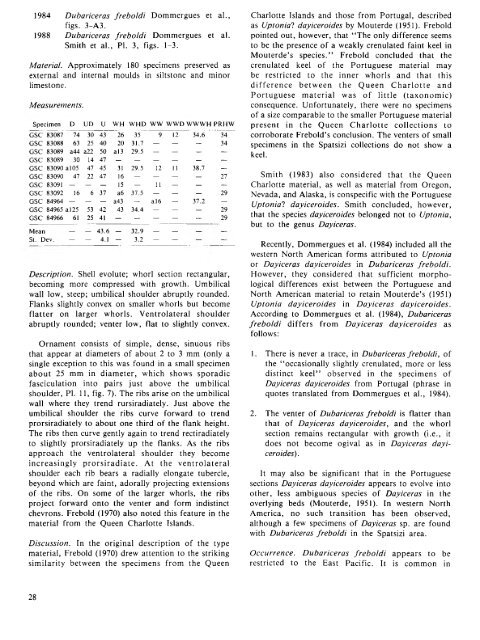PLIENSBACHIAN (LOWER JURASSIC) BIOSTRATIGRAPHY AND ...
PLIENSBACHIAN (LOWER JURASSIC) BIOSTRATIGRAPHY AND ...
PLIENSBACHIAN (LOWER JURASSIC) BIOSTRATIGRAPHY AND ...
Create successful ePaper yourself
Turn your PDF publications into a flip-book with our unique Google optimized e-Paper software.
1984 Dubariceras fre b o ld i Dommergues et al.,<br />
figs. 3-A3.<br />
1988 Dubariceras fre b o ld i Dommergues et al.<br />
Smith et al., PI. 3, figs. 1-3.<br />
Material. Approximately 180 specimens preserved as<br />
external and internal moulds in siltstone and minor<br />
limestone.<br />
M easurements.<br />
Specimen D UD U W H W H D W W W W D W W W H PRH W<br />
GSC 83087 74 30 43 26 35 9 12 34.6 34<br />
GSC 83088 63 25 40 20 31.7 — — — 34<br />
GSC 83089 a44 a22 50 al3 29.5 — — — —<br />
GSC 83089 30 14 47 — — — — — —<br />
GSC 83090 al05 47 45 31 29.5 12 11 38.7 —<br />
GSC 83090 47 22 47 16 — — — — 27<br />
GSC 83091 — — — 15 — 1 1 — — —<br />
GSC 83092 16 6 37 a6 37.5 — — — 29<br />
GSC 84964 — — — a43 — al6 — 37.2 —<br />
GSC 84965 al25 53 42 43 34.4 — — — 29<br />
GSC 84966 61 25 41 — — — — — 29<br />
Mean — — 43.6 — 32.9 — —<br />
St. Dev. — — 4.1 — 3.2 — —<br />
Description. Shell evolute; whorl section rectangular,<br />
becoming more compressed with growth. Umbilical<br />
wall low, steep; umbilical shoulder abruptly rounded.<br />
Flanks slightly convex on smaller whorls but become<br />
flatter on larger whorls. Ventrolateral shoulder<br />
abruptly rounded; venter low, flat to slightly convex.<br />
Ornament consists of simple, dense, sinuous ribs<br />
that appear at diameters of about 2 to 3 mm (only a<br />
single exception to this was found in a small specimen<br />
about 25 mm in diameter, which shows sporadic<br />
fasciculation into pairs just above the umbilical<br />
shoulder, PI. 11, fig. 7). The ribs arise on the umbilical<br />
wall where they trend rursiradiately. Just above the<br />
umbilical shoulder the ribs curve forward to trend<br />
prorsiradiately to about one third of the flank height.<br />
The ribs then curve gently again to trend rectiradiately<br />
to slightly prorsiradiately up the flanks. As the ribs<br />
approach the ventrolateral shoulder they become<br />
increasingly prorsiradiate. At the ventrolateral<br />
shoulder each rib bears a radially elongate tubercle,<br />
beyond which are faint, adorally projecting extensions<br />
of the ribs. On some of the larger whorls, the ribs<br />
project forward onto the venter and form indistinct<br />
chevrons. Frebold (1970) also noted this feature in the<br />
material from the Queen Charlotte Islands.<br />
D iscussion. In the original description of the type<br />
material, Frebold (1970) drew attention to the striking<br />
similarity between the specimens from the Queen<br />
Charlotte Islands and those from Portugal, described<br />
as U ptonial dayiceroides by Mouterde (1951). Frebold<br />
pointed out, however, that “ The only difference seems<br />
to be the presence of a weakly crenulated faint keel in<br />
Mouterde’s species.” Frebold concluded that the<br />
crenulated keel of the Portuguese material may<br />
be restricted to the inner whorls and that this<br />
difference between the Queen C harlotte and<br />
Portuguese material was of little (taxonomic)<br />
consequence. Unfortunately, there were no specimens<br />
of a size comparable to the smaller Portuguese material<br />
present in the Queen C harlotte collections to<br />
corroborate Frebold’s conclusion. The venters of small<br />
specimens in the Spatsizi collections do not show a<br />
keel.<br />
Smith (1983) also considered that the Queen<br />
Charlotte material, as well as material from Oregon,<br />
Nevada, and Alaska, is conspecific with the Portuguese<br />
U ptonial dayiceroides. Smith concluded, however,<br />
that the species dayiceroides belonged not to Uptonia,<br />
but to the genus Dayiceras.<br />
Recently, Dommergues et al. (1984) included all the<br />
western North American forms attributed to Uptonia<br />
or Dayiceras dayiceroides in D ubariceras freb o ld i.<br />
However, they considered that sufficient morphological<br />
differences exist between the Portuguese and<br />
North American material to retain Mouterde’s (1951)<br />
U ptonia dayiceroides in D ayiceras dayiceroides.<br />
According to Dommergues et al. (1984), Dubariceras<br />
fr e b o ld i differs from D ayiceras dayiceroides as<br />
follows:<br />
1. There is never a trace, in Dubariceras freboldi, of<br />
the “ occasionally slightly crenulated, more or less<br />
distinct keel” observed in the specimens of<br />
Dayiceras dayiceroides from Portugal (phrase in<br />
quotes translated from Dommergues et al., 1984).<br />
2. The venter of Dubariceras freb o ld i is flatter than<br />
that of Dayiceras dayiceroides, and the whorl<br />
section remains rectangular with growth (i.e., it<br />
does not become ogival as in Dayiceras dayiceroides).<br />
It may also be significant that in the Portuguese<br />
sections Dayiceras dayiceroides appears to evolve into<br />
other, less ambiguous species of Dayiceras in the<br />
overlying beds (Mouterde, 1951). In western North<br />
America, no such transition has been observed,<br />
although a few specimens of Dayiceras sp. are found<br />
with Dubariceras freb o ld i in the Spatsizi area.<br />
O ccurrence. D ubariceras fr e b o ld i appears to be<br />
restricted to the East Pacific. It is common in

















